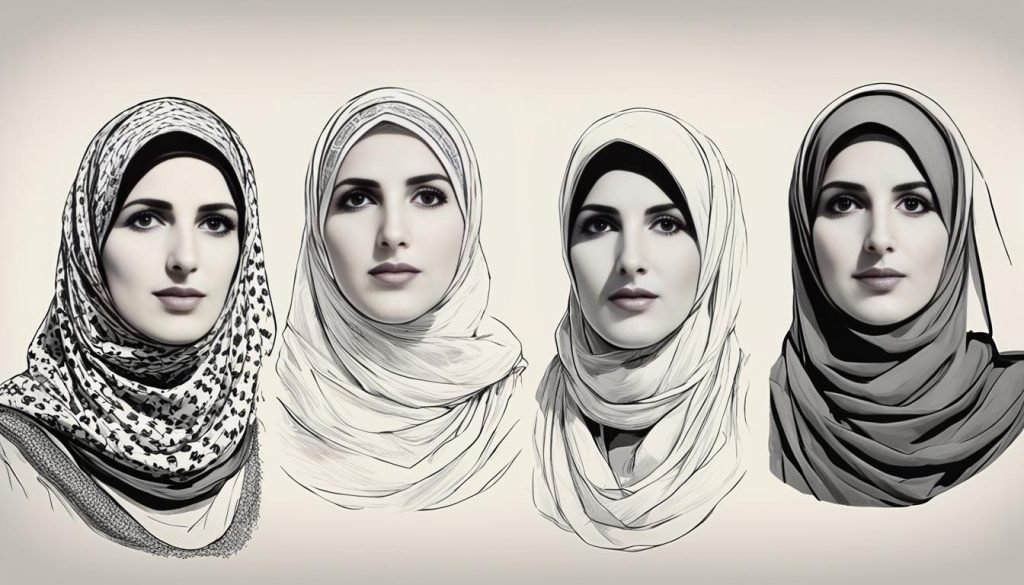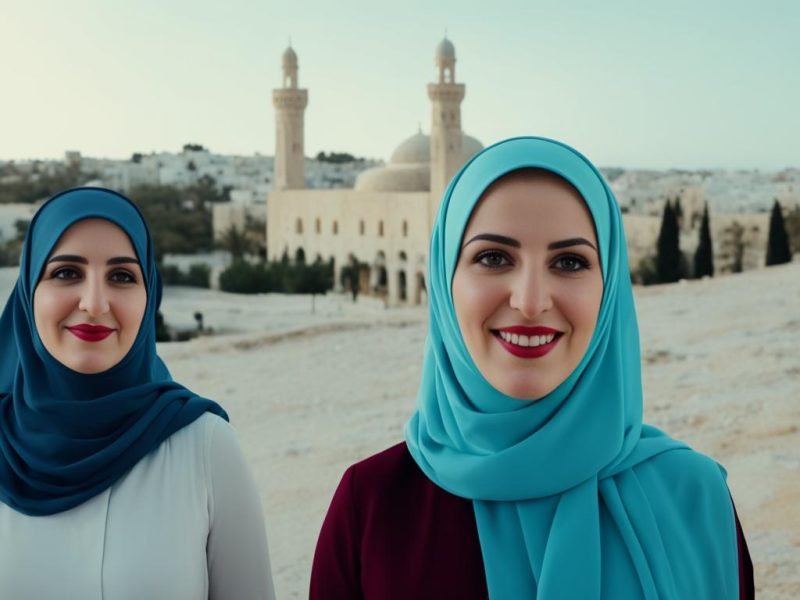Walking through Tunis, the warm breeze brings tales of old and new. It’s where history and today blend; a scene where Tunisia hijab laws and Tunisia women’s rights tell stories of battles, resilience, and hope. The alleys, filled with the smell of jasmine, display diverse religious clothing in Tunisia. This clothing stands for freedom and choice.
Now, the once quiet streets echo with women’s voices. They have welcomed a new age. An age where their rights are respected and their attire is their own choice.
Key Takeaways
- Legality of hijab wear in Tunisia reflects progress in women’s rights.
- Since the 2011 revolution, historical bans restricting hijab have been lifted.
- Steps towards addressing discrimination against veiled women have been significant.
- Contemporary Tunisia upholds the value of acceptance for religious clothing in public spaces.
- Personal accounts from Tunisian women highlight historical challenges and today’s transformations.
Understanding Tunisia’s Progressive Stance on Women’s Rights
In Tunisia, people respect women’s rights a lot. This is due to their laws, especially the Code of Personal Status. This code is all about fairness and moving forward. Even though Tunisia’s dress code has changed, the big changes started with laws and leaders who wanted to make things better for women.
Tunisia’s Code of Personal Status and its Impact on Women
In 1956, Tunisia made a big step for women’s rights by starting the Code of Personal Status. No other Arab country had done this before. It stopped men from having more than one wife and made divorce fairer. Because of this, Tunisian women got more control over their lives. They also got to vote, which was a huge step away from old traditions.
Transition from Bourguiba to Ben Ali: Changes in Women’s Legal Rights
Leaders like Habib Bourguiba and Zine el-Abidine Ben Ali changed legal rules to help women. Both wanted Tunisia to look modern to the world. They talked about difficult topics, like whether women should listen to their husbands. These talks were part of Tunisia’s effort to treat everyone the same.
National Holidays Celebrating Women in Tunisia
Tunisia celebrates women with special holidays like International Women’s Day and National Women’s Day. These days remind people of how important the Code of Personal Status is. They also show that Tunisia wants full equality for women, including choices about wearing the hijab.
Tunisia has worked hard to mix old traditions with new ideas. This effort is clear in their dress code and views on the hijab. They’ve done a lot for women’s rights, but there’s still more to do. The progress so far helps Tunisian women every day.
A Historical Overview of Hijab in Tunisian Society
Tunisia’s journey with the Islamic dress code shows its complex culture and women’s rights. I look into the history of Tunisia’s hijab laws, reflecting on Tunisian women’s various experiences. This highlights the efforts towards fair treatment. The laws and cultural patterns of Tunisia offer a clear view. They show the past, present, and future of Islamic attire in Tunisia.
The Evolution of Women’s Dress Code Since Tunisian Independence
Since gaining independence, Tunisia saw big changes in women’s dress code, reflecting broader social progress. The Code of Personal Status began these changes. Since then, attitudes have become more progressive. The Islamic dress code’s evolution in Tunisia shows a journey from political unrest to a bade of identity. It now stands tall in debates on women’s rights in Tunisia, especially after strict laws.
Bourguiba’s Ban on Hijab: Context and Consequences
President Habib Bourguiba’s time saw strict rules, including Circular 108, aiming to sideline the hijab. The effects of this ban lasted for years, leading to discrimination against visibly religious women. This period highlighted a gap. The government talked about modernisation, but women felt the weight of these policies. They struggled with their identity and beliefs.
Veiled Women’s Struggles during the 1980s and Beyond
The 1980s were tough for veiled women in Tunisia. Secular policies brought significant challenges to their lives. Yet, their determination set the stage for change and justice. Their fights are now key to discussions on women’s rights in Tunisia. These discussions grow as Tunisia finds its new identity after the revolution.

Religious Clothing in Tunisia: A Complex Societal View
Tunisia’s views on Religious clothing in Tunisia have significantly changed since gaining independence. The country’s laws today blend modern and traditional values. The acceptance of the hijab shows Tunisia balancing its history with a forward-looking approach.
The debate on Modesty in Tunisia is noticeable in Tunis. Despite past conflicts between Tunisian culture and the hijab, attitudes are now shifting. Tunisians are moving towards accepting religious dress, showing a balance between rights and cultural respect.
The discussion in Tunisia today supports personal belief and religious identity. It’s impressive to see women confidently wearing their faith. They navigate society and law with a newfound freedom in their dress.
In Tunis, opinions on religious clothing in Tunisia vary among people. But, a strong national dialogue is happening. It merges modesty with modern aspirations, all while holding onto Tunisian cultural values.
Can You Wear Hijab In Tunisia?
In contemporary Tunisia, you can indeed wear a hijab. This marks a change from past rules. The Tunisian view on religious dress like the hijab has become more open. It now shows a commitment to personal freedom and Tunisia women’s rights.
Modern Tunisia and the Legal Standing of Hijab
Tunisia’s laws now allow wearing a hijab. This shows a deep respect for religious diversity and personal freedom. It’s a big step forward for Tunisia women’s rights, in a country with many different beliefs.
Personal Accounts of Wearing Hijab in Tunisian Public Spaces
Even with legal rights, wearing a hijab in public can be challenging. Social attitudes and stereotypes still affect how veiled women are treated. But, there’s growing acceptance. The conversation about Can You Wear Hijab In Tunisia is moving towards normality and acceptance.
The Reality for Veiled Women in Education and Employment
Vestiges of past bans still cause issues in education and jobs for veiled women. These women’s stories are now influencing change. They are building a fairer society and strengthening Tunisia women’s rights.
Hijab Acceptance in Tunisia: Post-Revolution Changes
After the Arab Spring, Tunisia saw big changes, especially for women’s rights and hijab acceptance. The revolution changed how people viewed women’s freedom to choose what to wear.
The Impact of the Arab Spring on Women’s Clothing Freedom
Since the revolution, Tunisia has made great progress in personal freedoms. The Arab Spring helped change views on the hijab, moving from restriction to freedom. As a journalist, I’ve seen this shift. The hijab now symbolizes Tunisia’s embrace of diversity and women’s choices.
Testimonies from the ‘Transitional Justice is Also for Women’ Network
The ‘Transitional Justice is Also for Women’ Network shares stories of changing attitudes towards the hijab in Tunisia. These stories show the struggles and wins of women who wore the hijab. They are not just stories; they light the way to a future where everyone is equal and included.
This change is seen in Tunisian women’s fashion, including the hijab. It shows a move towards freedom and rights. Women’s strength and dedication to equality highlight the progress in hijab acceptance in Tunisia. It’s a step towards a fairer society.
Tunisia Dress Code and Tourism: What Visitors Should Know
When exploring Tourism in Tunisia, questions about the Tunisia dress code come up. It’s about what to wear, including the hijab. I suggest wearing clothes that reflect your personal values. Tunisia warmly welcomes different cultural expressions, including religious ones. Yet, it’s wise for tourists to dress modestly. This respect matters a lot, especially at religious and historic places.

Dressing with modesty enriches your travel experiences. Here’s a simple guide for tourists on choosing the right outfits for their visit:
| Setting | Recommended Attire | Notes |
|---|---|---|
| Urban/Modern Areas | Comfortable, casual wear | Liberal dress; respect for local modesty norms suggested. |
| Beaches/Resorts | Swimwear, sun hats, cover-ups | Beachwear is common, but cover-ups are recommended when leaving the beach area. |
| Traditional Markets (Souks) | Modest clothing, closed-toe footwear | Bargains and local goods; modesty appreciated. |
| Religious Sites | Modest attire, headscarves for women | Some mosques allow non-Muslim visitors outside prayer times; photography may be restricted. |
| Rural/Villages | Conservative clothing | Highly traditional settings; a respectful approach to dress can facilitate interactions. |
Knowing the modesty in Tunisia shows respect and makes travel richer. It’s not just about following rules. It’s about experiencing Tunisia’s heritage and hospitality. As a believer in conscious tourism, I urge visitors to truly connect with local customs and values.
Tunisian Culture and Hijab: The Public Perception Today
In today’s Tunisia, opinions on the hijab are complex. They mix the country’s history of secularism with Islamic values. Hijab and Tunisian culture symbolise a debate on freedom and societal norms. This is particularly true regarding modesty in Tunisia. The mix of progressive secularism and Islam’s traditions creates a unique social scene. Here, how women dress speaks volumes about both personal choice and cultural identity.
Cultural Norms and Modesty in Current Tunisian Society
Modesty is key in Tunisia’s dress code. It dictates how people choose to dress every day. Combining hijab with Tunisian culture shows a balance between modern and traditional views. This balance reminds us that modesty in Tunisia changes with the times. It grows with the country’s shared mindset.
The Influence of Secularism and Islam on Women’s Attire
In Tunisia, secularism still affects life and law, influencing views on the hijab. But secularism now also supports the choice to wear religious clothes. It is a big change from past rules limiting religious freedom. Now, secular and Islamic ideas blend well in Tunisia. This blend enriches the nation’s cultural depth.
| Time Period | Secular Influence | Islamic Influence | Public Attitude Towards Hijab |
|---|---|---|---|
| Pre-2011 | High; restrictive on religious symbols | Low visibility in public policies | Generally negative with legal and societal limitations |
| Post-2011 | Moderate; protective of religious freedom | Gaining prominence in shaping social values | More positive with increasing acceptance and respect |
The hijab’s role in Tunisia has evolved. It now reflects a society open to liberal ideas. This shows a broader acceptance of modesty in Tunisia. It also highlights how secularism in Tunisia has changed. Now, it supports diversity in religious dress as part of Tunisia’s rich culture.
Modesty in Tunisia: A Multifaceted Concept
In exploring Tunisia’s culture, we find that modesty is a complex idea. It deeply intertwines with the nation’s diverse cultural and religious beliefs. Both modern attitudes and traditional values respect modest clothing. This shows in how Tunisians view the hijab. It’s seen as a personal clothing choice, reflecting tolerance and diversity.
The Islamic dress code in Tunisia changes with society and politics. It respects ‘custom and tradition’, adapting to new societal trends. This blend of old and new allows Tunisian women to choose how they express themselves. Thus, the hijab and other modest clothing reflect evolving beliefs, empowering women.
To understand modesty in Tunisia, we must see it as ever-changing. It evolves with the nation’s progress and cherished traditions. The Islamic dress code shows the freedom and rights of Tunisian women. It underscores the aim to foster an inclusive culture that honours both past and present.







